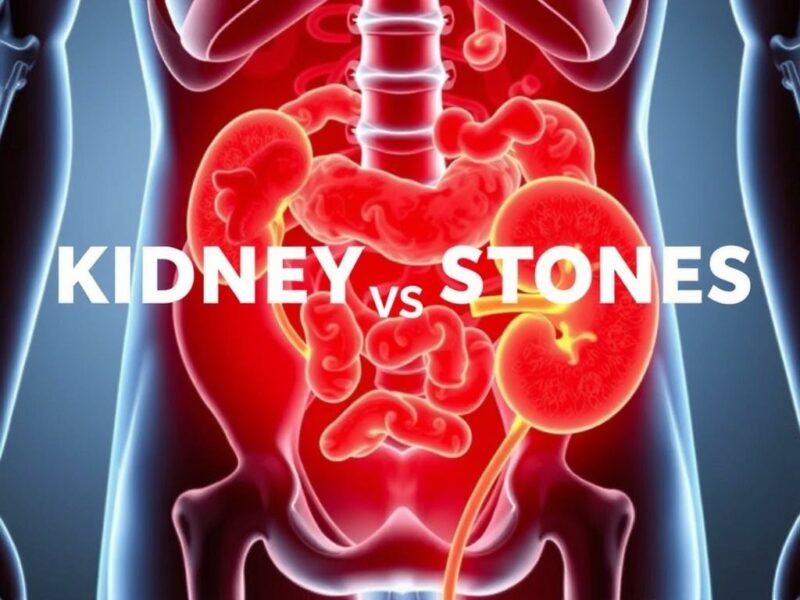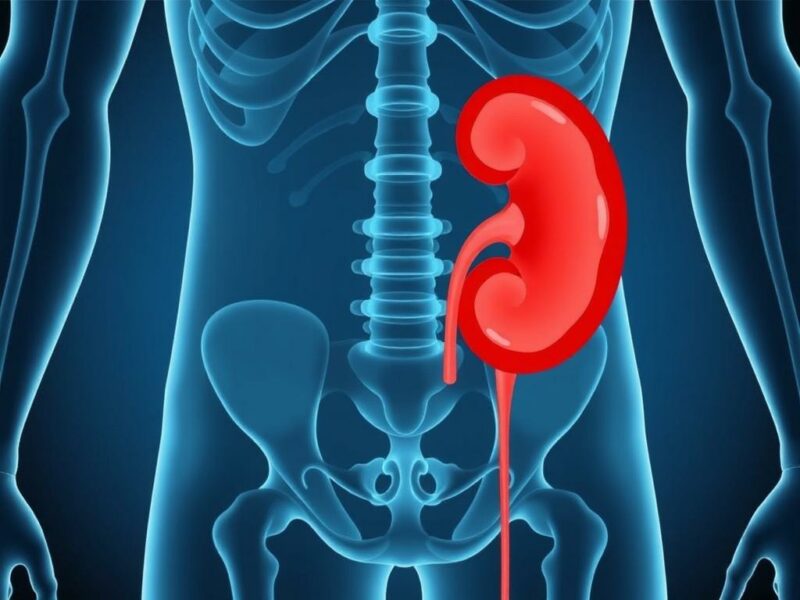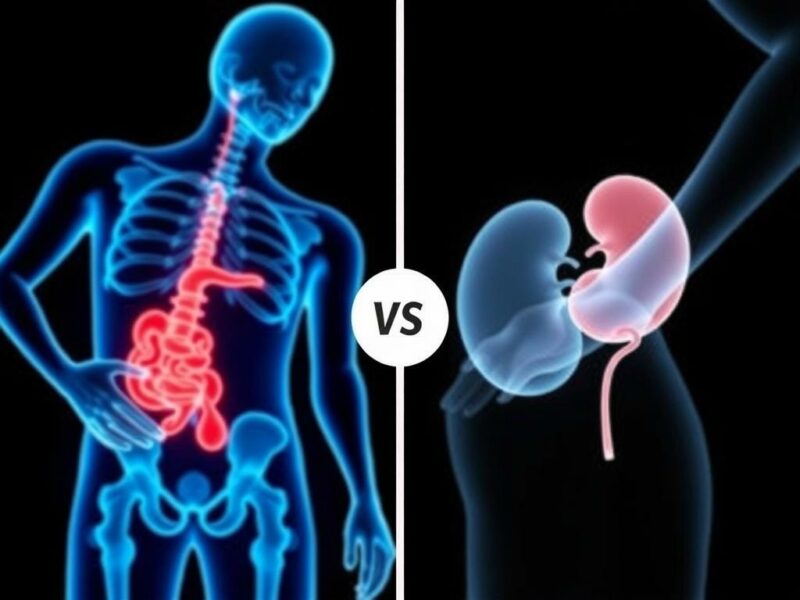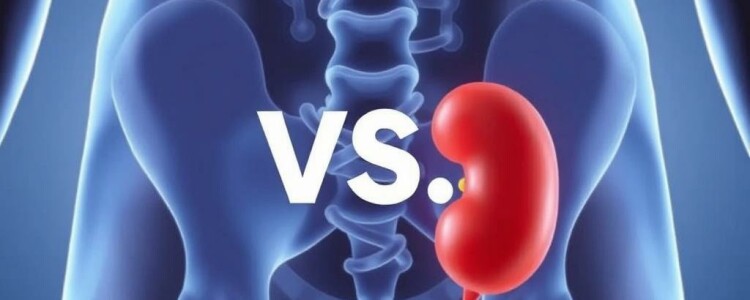When sudden, severe abdominal pain strikes, it can be alarming and confusing. Two common culprits behind such discomfort are appendicitis and kidney stones. Though both conditions affect the abdominal area and cause intense pain, their causes, symptoms, diagnosis, and treatment differ significantly. Understanding these differences can help you recognize the signs early, seek prompt medical care, and avoid serious complications.
Appendicitis is the inflammation of the appendix, a small tube-like organ attached to the large intestine. When inflamed, it causes sharp, localized pain that typically begins near the navel and then shifts to the lower right side of the abdomen. In contrast, kidney stones are hard deposits made of minerals and salts that form inside your kidneys. They cause pain when they move into the urinary tract, often leading to severe, cramping pain that can radiate from the back to the groin.
Let’s take a deep dive into the key differences between appendicitis vs. kidney stones, breaking down the causes, symptoms, diagnosis, treatment approaches, and prevention tips for each condition. By the end, you’ll have a clearer understanding of how to differentiate these conditions, recognize them early, and make informed decisions about your health.
What Causes Appendicitis?
Appendicitis starts when the appendix becomes blocked due to factors like infection, stool buildup, or swelling of lymph tissue inside the appendix. This blockage prevents normal mucus drainage, leading to inflammation and sometimes infection. If untreated, the appendix can rupture, spilling infectious contents into the abdominal cavity, which can be life-threatening.
The exact cause of this blockage can vary. Common triggers include:
- Infections in the digestive tract leading to swollen lymph nodes
- Foreign bodies or stool causing obstruction
- Trauma or injury to the abdomen
Appendicitis can affect anyone but is most common in people between ages 10 and 30. Recognizing early signs is crucial because the appendix can rupture within 24 to 72 hours after symptoms appear.
What Causes Kidney Stones?
Kidney stones form when certain substances in the urine, such as calcium, oxalate, and uric acid, become too concentrated and crystallize. These crystals can grow into stones, which may remain in the kidney or travel down the ureters toward the bladder.
Several factors increase the risk of forming kidney stones, including:
- Dehydration or low fluid intake leading to concentrated urine
- Diet high in salt, sugar, and animal protein
- Obesity and metabolic conditions such as diabetes
- Family history of kidney stones
- Certain medical conditions like gout or hyperparathyroidism
Unlike appendicitis, kidney stones can vary in size—from tiny grains to stones as large as a golf ball—and the symptoms largely depend on their size and movement.
Symptoms: Appendicitis vs. Kidney Stones
Identifying whether your pain stems from appendicitis or kidney stones often depends on patterns of symptoms. Here’s a breakdown to help you spot the differences:
| Symptom | Appendicitis | Kidney Stones |
|---|---|---|
| Location of Pain | Starts near navel, shifts to lower right abdomen | Flank or back pain, radiating to lower abdomen or groin |
| Type of Pain | Sharp, steady, worsening over time | Severe, cramping, comes in waves |
| Other Symptoms | Nausea, vomiting, fever, loss of appetite | Blood in urine, frequent urination, burning sensation when urinating |
| Onset | Gradual, worsens over hours | Sudden, intense episodes |
One key difference is that appendicitis pain tends to be continuous and worsens steadily, whereas kidney stone pain comes in spasms or waves as stones move through the urinary tract. Additionally, kidney stones often cause urinary symptoms such as burning or blood in the urine that are rare in appendicitis.
Diagnosing Appendicitis and Kidney Stones
If you experience severe abdominal pain, a doctor will perform a thorough physical exam and request tests to determine the cause.
For appendicitis, the diagnosis usually involves:
- Physical examination focusing on the abdomen to check for tenderness and rebound pain
- Blood tests showing elevated white blood cell count indicating infection
- Ultrasound or CT scan to visualize an inflamed appendix
Diagnosing kidney stones typically includes:
- Urinalysis to look for blood or infection
- Imaging tests such as an X-ray, ultrasound, or CT scan to locate stones
- Blood tests to evaluate kidney function and detect high mineral levels
Sometimes, the symptoms can overlap, making imaging studies critical to distinguishing between appendicitis vs. kidney stones accurately.
Treatment Options: Appendicitis vs. Kidney Stones
Once diagnosed, the treatment paths for appendicitis and kidney stones differ greatly.
Treating Appendicitis
Appendicitis is almost always treated as a surgical emergency. The most common procedure is an appendectomy – surgical removal of the appendix. This can be done through:
- Laparoscopic surgery (minimally invasive, faster recovery)
- Open surgery (for complicated or ruptured cases)
If appendicitis is caught very early, some doctors may attempt a course of antibiotics as initial treatment, but surgery remains the definitive cure. Delaying surgery increases the risk of rupture and serious infections like peritonitis.
Treating Kidney Stones
Treatment for kidney stones depends on their size, location, and symptoms:
- Small stones may pass on their own with increased fluid intake and pain management
- Medications like alpha-blockers can help relax ureter muscles to facilitate stone passage
- Larger stones or those causing obstruction may require procedures such as shock wave lithotripsy to break stones apart or surgical removal
- In rare cases, ureteroscopy allows doctors to retrieve or break stones using a small scope inserted through the urinary tract
Pain control is essential during kidney stone episodes, often requiring NSAIDs or stronger medications.
Preventing Appendicitis and Kidney Stones

While appendicitis isn’t always preventable, a healthy diet and prompt treatment of digestive infections can lower risks. Kidney stones, on the other hand, are more manageable through lifestyle changes.
Here’s a helpful table comparing prevention strategies:
| Prevention Strategy | Appendicitis | Kidney Stones |
|---|---|---|
| Diet | High fiber intake to avoid constipation | Limit salt, animal protein, and oxalate-rich foods (spinach, nuts) |
| Hydration | Maintain good hydration to promote digestive health | Drink plenty of water to prevent concentrated urine |
| Infection Control | Promptly treat gastrointestinal infections | Maintain urinary tract health |
| Medical Monitoring | Monitor abdominal pain and seek early care | Regular check-ups if prone to stones |
Making these adjustments can significantly reduce the chance of kidney stone formation and possibly lower your risk of digestive issues leading to appendicitis.
When to See a Doctor: Urgent Signs

Both appendicitis and kidney stones can become emergencies. Seek immediate medical help if you experience:
- Sudden, severe abdominal pain that worsens quickly
- Persistent vomiting or inability to keep fluids down
- Swelling or tenderness in the abdomen
- High fever or chills
- Blood in urine or difficulty urinating
- Signs of shock such as dizziness or fainting
Timely evaluation can prevent complications such as appendix rupture or kidney damage.
Comparing Appendicitis vs. Kidney Stones: Summary Table
For a quick overview, here’s a side-by-side comparison of key aspects:
| Feature | Appendicitis | Kidney Stones |
|---|---|---|
| Cause | Inflammation/blockage of appendix | Crystals forming stones in kidneys |
| Main Symptom | Lower right abdominal pain | Flank/back pain radiating to groin |
| Onset of Pain | Gradual, persistent | Sudden, cramping |
| Additional Symptoms | Fever, nausea | Urinary symptoms, blood in urine |
| Treatment | Appendectomy (surgery) | Fluids, pain meds, possible surgery |
| Prevention | Early infection treatment | Hydration, diet management |
Living with the Experience: Patient Perspectives

Hearing real stories from those who have faced appendicitis or kidney stones can shed light on what to expect.
Many patients describe appendicitis pain as relentless and intensifying, often mistaken initially for indigestion or gas. The sudden shift of pain to the lower right abdomen often prompts urgent hospital visits. Post-surgery, recovery is typically swift with few complications when caught early.
Kidney stone sufferers commonly recall waves of excruciating pain and nausea, often describing it as one of the worst pains experienced. Passing a stone naturally is painful but rewarding, while some require multiple procedures to manage recurrent stone formation.
Tips for Coping with Pain and Recovery
- Stay hydrated and rest as much as possible
- Use prescribed pain medications responsibly
- Follow up with your healthcare provider promptly
- Adopt dietary and lifestyle changes to prevent recurrence
Understanding and empathizing with patient experiences can help reduce anxiety when facing these conditions and encourage proactive care.
Conclusion
Appendicitis and kidney stones are two distinct conditions that share abdominal pain as a common feature, but their causes, symptoms, diagnosis, and treatments differ markedly. Recognizing the differences between appendicitis vs. kidney stones is vital for seeking timely medical attention and avoiding complications. While appendicitis typically requires urgent surgery, kidney stones may resolve with conservative management or need surgical intervention depending on their size and symptoms. Prevention strategies, particularly for kidney stones, can significantly reduce risks through hydration and dietary choices. If you or someone you know experiences sudden, severe abdominal pain, understanding these conditions can empower you to act quickly and get the right care, ensuring better outcomes and peace of mind.



